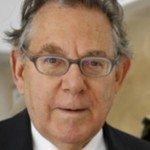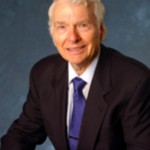Frontiers in Atmospheric Chemistry.
 Title: Changes in the Oxidative Power of the Atmosphere Due to Human Activities by Paul Crutzen, Max-Planck-Institute for Chemistry Mainz, West Germany
Title: Changes in the Oxidative Power of the Atmosphere Due to Human Activities by Paul Crutzen, Max-Planck-Institute for Chemistry Mainz, West Germany
Abstract: The measured changes in CH4 and CO concentrations, and enhancements in NOx emissions by fossil and biomass fuel burning have led to important changes in the global distributions of ozone and hydroxyl radicals. As part of a European effort on the three-dimensional modelling of tropospheric chemistry, estimates are made on the changes which have taken place in the global distributions of ozone and hydroxyl.
Since pre-industrial times we find that ozone concentrations have increased in the northern hemisphere, but that on the other hand global average OH concentrations have declined, leading to a buildup of trace gases in the troposphere. Brochure
Title: Measurements and Implications of Photochemically Active Trace Species in the Remote Atmosphere by Brian Ridley, The National Center for Atmospheric Research Atmospheric Chemistry Division Boulder, Colorado
Abstract: Much of the atmosphere over the Pacific Ocean region is still believed to be relatively free from direct anthropogenic influence and it therefore has some semblance of the background troposphere. By area, the ocean represents roughly 35% of the earth’s surface. Due to the remoteness of the region, measurements of some photochemically important trace species also present an interesting challenge. In an effort to further our understanding of the abundances, budgets, photochemical transformations, and influence of long range transport processes, a five week study was conducted at the Geophysical Monitoring for Climatic Change (GMCC) station at the 11,000 ft level on Mauna Loa, Hawaii in the spring of 1988. During this experiment, called the Mauna Loa Observatory Photochemistry Experiment (MLOPEX), a variety of photochemically related trace species including NOx, NOy, HNO3, NO3-, O3, NMHCs, J(NO2), HOOH, H2CO, PAN, organic nitrates and other peroxides were continuously measured in addition to many other measurements that are routinely made at the GMCC station. Results from this experiment will be presented and will be compared with photochemical models, with measurements made previously from aircraft programs in the Pacific, and with measurements made in continental regions. In particular, the ozone photochemical tendency, partitioning of total odd nitrogen and implications for the abundance of peroxyl and hydroxyl radicals will be discussed.
In addition, and because thunderstorms may be significant source of odd nitrogen species to the global free troposphere, some results from recent aircraft flights within the anvils of thunderstorms will be presented. Brochure
 Title: Regional Ozone Production by Fred C. Fehsenfeld National Oceanic and Atmospheric Administration U.S. Department of Commerce
Title: Regional Ozone Production by Fred C. Fehsenfeld National Oceanic and Atmospheric Administration U.S. Department of Commerce
Abstract: Ozone plays a key role in tropospheric chemistry and global climatology. In addition, ozone is a secondary pollutant, and elevated levels of ozone can damage forests and crops and may be harmful to human health. For these reasons, ozone represents an important component of air quality problems in urban areas, and an emerging air quality problem in rural areas. Most ozone is formed photochemically from ozone precursors, the oxides of nitrogen, NOx, and non-methane hydrocarbons, NMHC. However, these reactions are exceedingly complex, many of the key processes poorly understood, and the rate of emission of the important precursor compounds into the atmosphere uncertain. For these reasons, understanding the process responsible for ozone production represents an important and challenging problem. Our present understanding of the processes that shape the regional ozone distribution will be briefly reviewed, and the sources of the key precursor compounds examined. The implication of recent field measurement campaigns to the understanding of these processes will be discussed. Brochure
Title: Studies of the N02-NOS-N205 System by Jack G. Calvert Atmospheric Chemistry Division National Center for Atmospheric Research Boulder, Colorado
Abstract: The nitrate radical, NO3, through it reactions involving NO2 and N2O5,
NO3 + NO2 = N2O5 (1)
is important in controlling the levels of active nitrogen and the partitioning of NO and NO2 in both the troposphere and the stratosphere. Measurements of NO3 in the atmosphere have not been successfully reconciled with attempts to model its concentration. This suggests that some fundamental rate and/or spectroscopic parameters may not be known with sufficient accuracy today. The Atmospheric Kinetics and Photochemistry group (including G.S. Tyndall, J. J. Orlando, C.A. Cantrell, R.E. Shetter) within NCAR have redetermined the cross sections of each of these molecules, equilibrium constant for (1) and the rate coefficients for both the formation (2) and decomposition (3) of N2O5 as a function of pressure and temperature.
NO3 + NO2 + N2 \ N2O5 + N2 (2)
N2O5 + N2 \ NO3 + NO2 + N2 (3)
These rate data, combined with previous measurements over a more limited temperature and pressure range, provide a more complete data set which can be used to define the falloff characteristics of the rate coefficients k2 and k3 in atmospheric modeling. Comparisons of the ratio of rate coefficients k2/k3 at a given pressure and temperature with measured values of K1 allow a check in the consistency of the present data. Brochure
 Title: Isotopes in Stratospheric Ozone by Ralph J. Cicerone Department of Geosciences, School of Physical Sciences University of California, Irvine
Title: Isotopes in Stratospheric Ozone by Ralph J. Cicerone Department of Geosciences, School of Physical Sciences University of California, Irvine
Abstract: Observations have shown that stratospheric ozone is isotopically heavier than it would be if it contained only statistical proportions of 16O, 17O, and 18O.
Attempts to predict and/or explain the isotopic ratios have failed; no model accounts for the observed enrichments of heavy oxygen despite a growing number of studies from theory and laboratory experiments. An explanation of the isotopic data is desirable even if it would not greatly alter our views of stratospheric photochemistry. I will review what is known and attempt to isolate several likely possible mechanisms whose investigation could resolve the problem. Brochure
